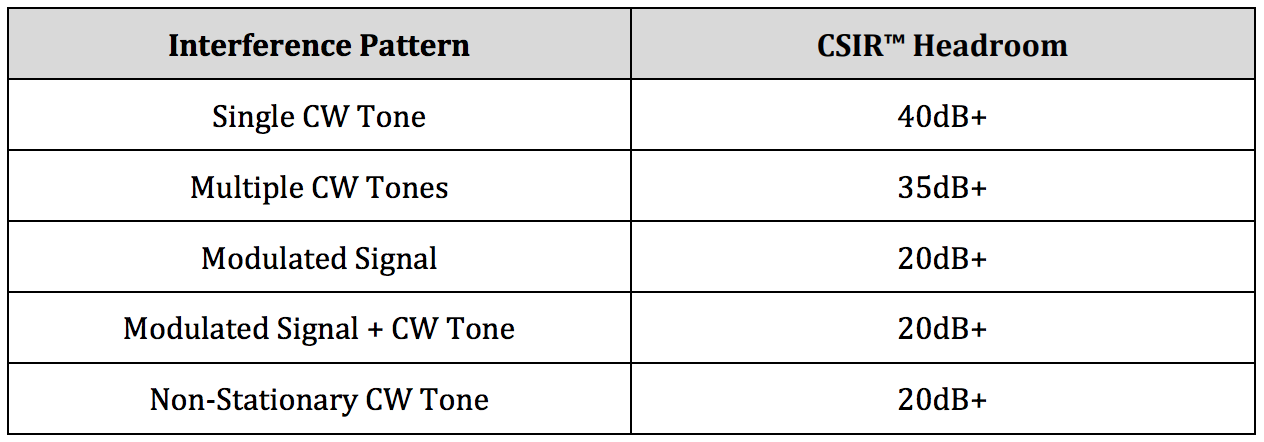Radio frequency interference in satellite communications is a growing concern for military and commercial users alike. With increasing spectral density and frequency overlap, interference incidents have become commonplace — reported interference cases (a small subset of overall interference cases) reached 20,000 reported incidents per year in 2016. With Low Earth Orbit (LEO) satellite constellations and 5G terrestrial players entering the SATCOM landscape, this number will experience tremendous growth.
This growing incidence of interference highlights the need for improved interference mitigation capabilities. Existing interference mitigation techniques burden satellite operators and network owners with expensive, inflexible architectural design and/or significant bandwidth constraints.

For example, orthogonal interference mitigation techniques, such as MIMO and CDMA, require architectural expenditures and system complexity. Other techniques, such as frequency hop (FH) and adaptive coding and modulation (ACM) trade off throughput for interference resilience and again burden system design with additional complexity.
Glowlink’s Interference Removal Algorithm
Glowlink’s Communication Signal Interference Removal (CSIR™) simplifies the interference resilience solution — interference resilience with no tradeoffs or additional burden.

CSIR can be inserted into any receive chain and mitigate unknown interference in a variety of interference scenarios with zero added complexity for everyone from the system architect to the terminal operator. The primary design focus of CSIR leverages existing knowledge of the operator’s signal of interest (SOI), namely SOI symbol rate and center frequency, to deliver interference resilience.
CSIR does not require any information about the interfering signal. As a mature, DSP-based solution, CSIR is offered in a wide range of configurations: from an in-line unit that can fit into existing satellite receive paths all the way down to an IP core on a field programmable array (FPGA) integrated directly into a modem.
CSIR takes an approach that requires no additional operator knowledge to set up and no satellite operator intervention when an interference event occurs. The satellite operator already has all the necessary CSIR setup knowledge — SOI symbol rate and center frequency — since the receive modem must be configured with the same information. There is no need to tell the algorithm that an interference is present; the algorithm will simply begin working once interference appears. This is a key point in understanding the value- add of CSIR. Once CSIR is set up, the operator could be taking a nap in a hammock when an interference arises, and CSIR would still deliver full interference resilience.
Both in the development laboratory and in the field, CSIR has shown significant performance against a wide variety of interference patterns. Users for CSIR have ranged from PhD-level scientists to novice satellite communication operators. Thanks to CSIR’s operator-centric design focus, the entire range of users has been able to install the technology and protect their communication link from interference.
CSIR Performance Metrics and Examples
As a novel interference removal approach, CSIR requires the definition of a new performance metric in order to fully articulate the algorithm’s power. Glowlink has defined ‘headroom’ as its interference removal metric. Headroom is defined as the increase in maximum interference power that a receive link can tolerate with CSIR in- line.

Specifically, the bit error rate (BER) of a modem will remain quasi-error free (QEF) down to some minimum C/ (N+I), where C is SOI power, N is noise level, and I is interference power. By mitigating interference, CSIR allows the receive modem to operate QEF at a higher I, or correspondingly lower C/ (N+I), than an unprotected modem. Practically, when taking a headroom measurement in the lab, we operate two receive modems side by side. One has CSIR protection; the other serves as an unprotected reference. We set C, I, and N to a level where the unprotected reference is still QEF.
We raise I to Iref where our reference modem BER is no longer QEF. We then further raise I to ICSIR where our protected modem is no longer QEF. Headroom is ICSIR — IRef.
Headroom is a function of many elements — from SOI characteristics to interference patterns to noise levels to desired FPGA resource utilization. As a result, the number of headroom measurements is infinitely long. To give a rough order-of-magnitude understanding of CSIR’s capabilities, the following table has been developed for headroom measurements achieved with a QPSK LDPC-2/3 SOI.
This performance sample represents a drop in the proverbial results bucket. For more information and further details, please contact Glowlink directly.
CSIR is able to provide ample interference rejection performance with minimal burden on the operator. With interference resilience that requires no operator intervention, minimal additional equipment, and no additional operator information, CSIR is an impactful, efficient solution to the growing interference problem.
 Figure 1.
Figure 1.
Complimenting Existing Interference-Resilience Approaches
CSIR can be an additive measure to systems that already have interference mitigation designs.
From MIMO to FH, CSIR can provide additional interference resilience to a protected communication link. For schemes that require increased architectural complexity, CSIR can be a tool to help minimize the cost and burden of that architectural complexity. For schemes that trade communication data throughput for interference resilience, CSIR can help maximize the achievable data throughput.
With its flexible implementation, CSIR is harmonious with existing interference resilience techniques, ready to be delivered in the appropriate form factor.
GS380X — CSIR Implementation
The GS380X is a powerful inline interference removal system utilizing Glowlink’s CSIR algorithm to provide the user with continuous, real-time interference excision and link protection. The GS380X is placed into the signal receive path directly before the modem and, with the CSIR algorithm, protects the communication link from interference ranging from multiple CW tones to strong modulated interferers (see Figure 1).
The GS380X prioritizes existing operators and legacy satellite communication systems by introducing zero additional constraints on the system-wide architecture to achieve significant interference resilience. As with all CSIR-based products, the GS380X does not require operator intervention to deliver protection during interference events.
By minimizing cost and maximizing simplicity, the GS380X offers efficient interference resilience as an additive capability that does not require system redesign. Even for systems that already have existing interference-resilience capabilities, the GS380X can be used to deliver additional resilience against interference.
The newest generation of this product has improved bandwidth capabilities over the original GS380X. For further details, please contact Glowlink directly.
RCM — Wideband Implementation
The RCM is a high-performance version of the GS380X intended for use by the United States government and allies. For those requiring a high-bandwidth, high-performance system, the RCM can deliver similar to enhanced interference excision capabilities in a compact form factor. For further details, please directly contact Glowlink.
GS380S — Interference-Preserving Implementation
The GS380S is a variant of the GS380X that also preserves the interference signal. In addition to protecting the SOI from the interference, it also produces a cleaned-up version of the interference itself as a secondary output. For those interested in knowing more about their interference signal, the GS380S provides an interference observation capability.
GS380L — Geolocation Implementation
The GS380L is a variant of the GS380X that is designed as a companion to the Glowlink Model 8000 Geolocation device. The GS380L removes competing signals on both the primary and adjacent satellites to provide a cleaner, more accurate geolocation result. Paired with the Glowlink Model 8000, the GS380L has successfully resolved geolocation cases that were previously not possible with any geolocation system.
IP CORE — Integrated CSIR
For those interested in direct integration onto an FPGA, CSIR is available as a licensable IP-block. The IP Core works at clock speeds specified to the top of the satellite communications bandwidth range. In addition, the already modest resource consumption of the IP Core can be further optimized for available FPGA space. Depending on the urgency of the customer, this IP Core can be available immediately.

For further information, contact the Glowlink team at sales@glowlink.com, visit the company’s website at www.glowlink.com, or call the firm at (650) 237-0220.
Author Philip Chu is the Senior Technical Projects Manager for Glowlink Communications Technology

